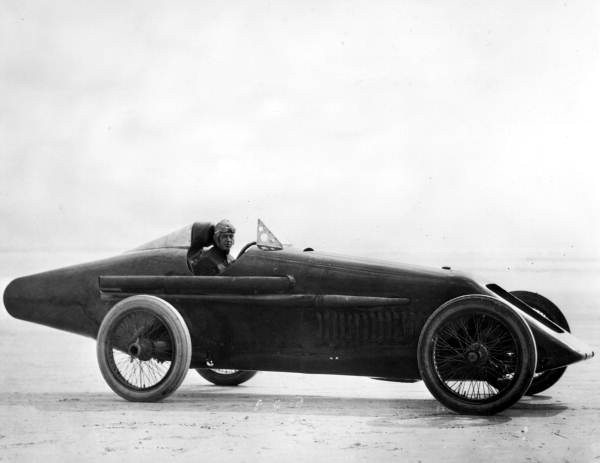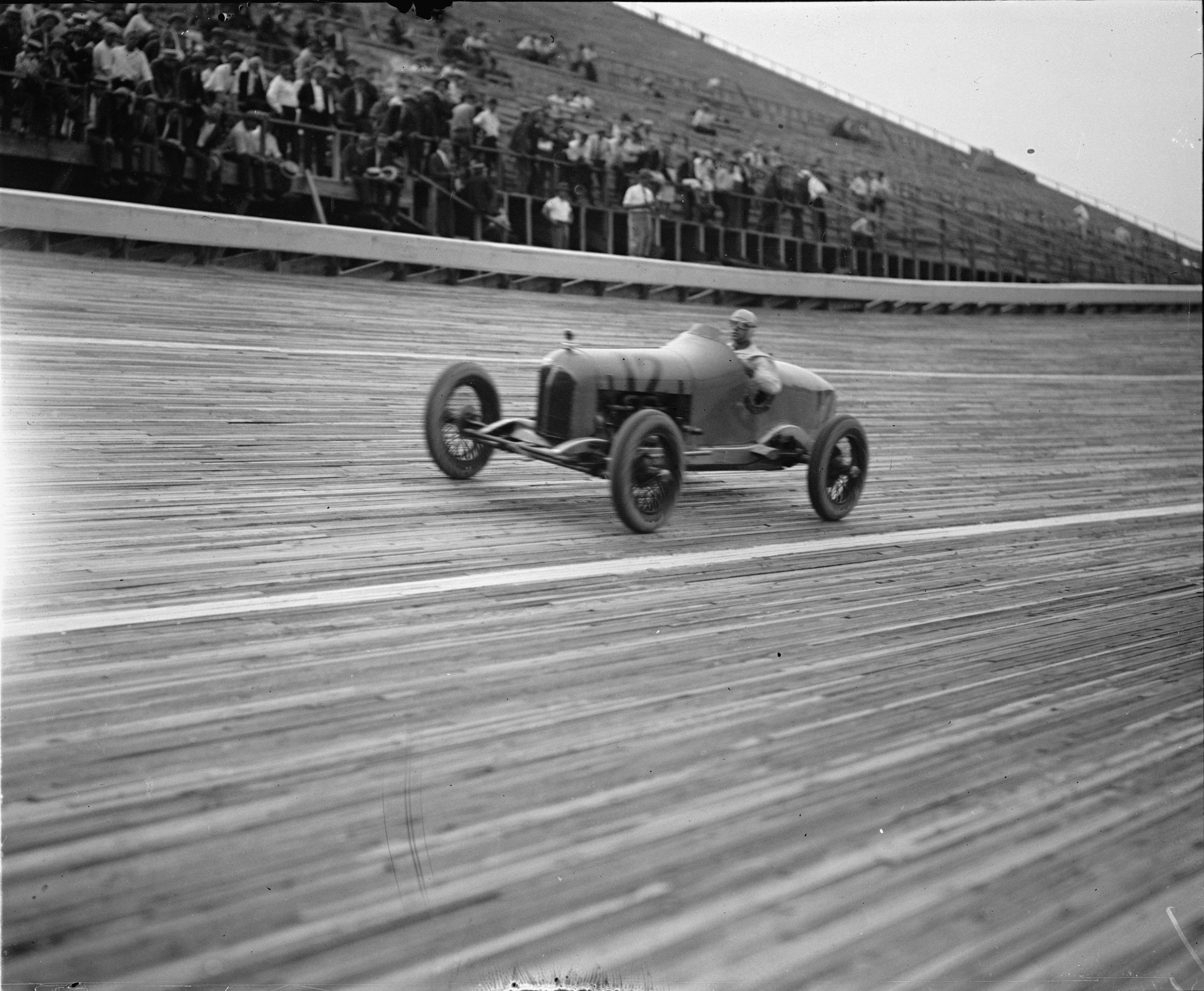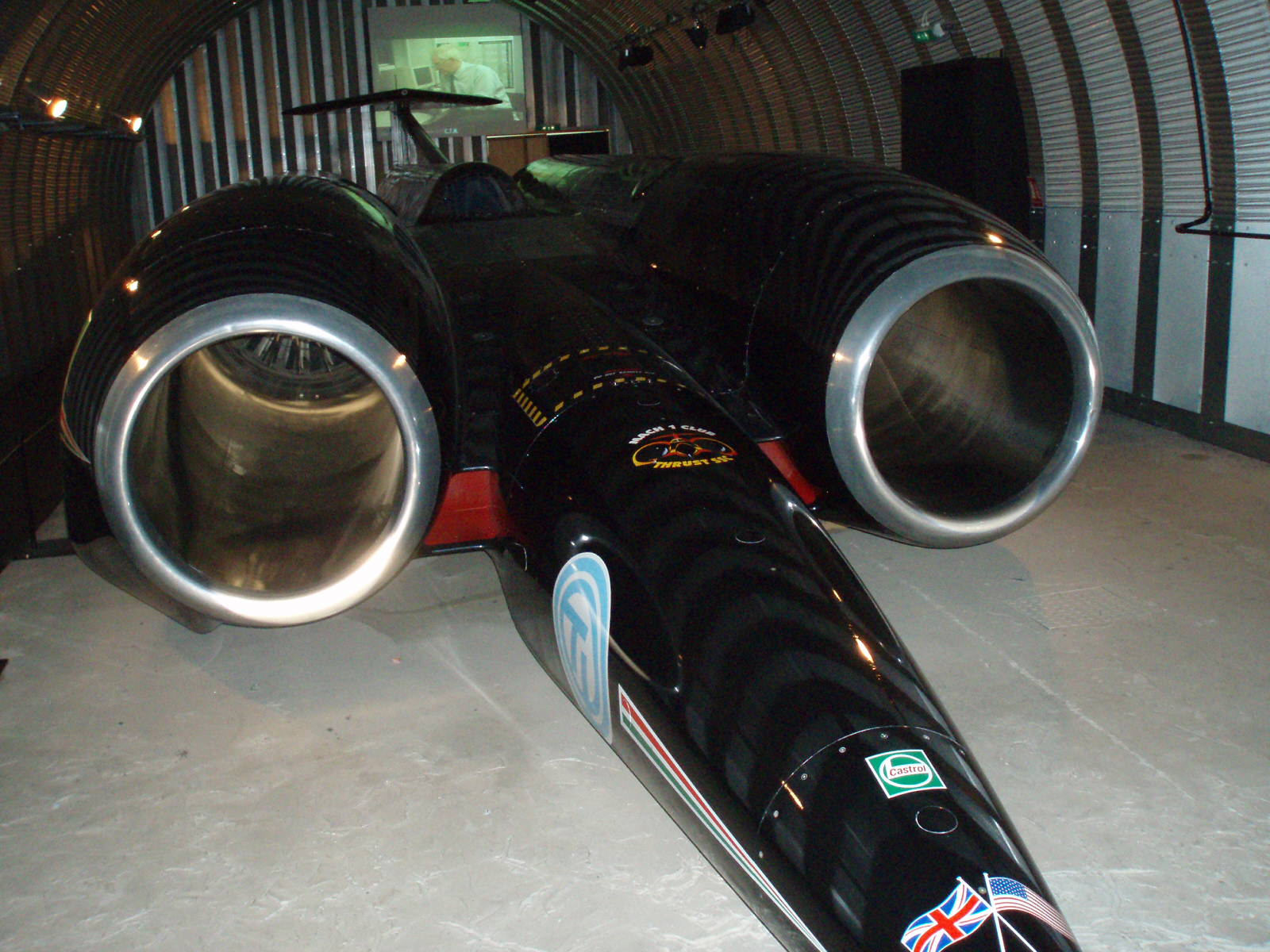|
1928 Indianapolis 500
The 16th International 500-Mile Sweepstakes Race was held at the Indianapolis Motor Speedway on Wednesday, May 30, 1928. This was the first Indianapolis 500 presided over by new Speedway president Eddie Rickenbacker. Rain threatened to wash out the day, but the showers stopped and the race started on time. One brief shower slowed the race around the 400-mile mark, bringing out the yellow flag for a few laps. It was the third year contested with the supercharged 91 cu. in. (1.5 L) displacement engine formula. A total of seven supercharged front-wheel drive cars were entered, and they swept the front row during time trials. Leon Duray in a Miller took the pole position with an average speed of , a new track record. Duray dominated much of the first half of the race, setting a blistering pace. He dropped out in the second half, however, due to an overheating engine. With twenty laps to go, Tony Gulotta led Jimmy Gleason and Louis Meyer. All three cars were running nose-to-tail. ... [...More Info...] [...Related Items...] OR: [Wikipedia] [Google] [Baidu] |
AAA Contest Board
AAA, Triple A, or Triple-A is a three-letter initialism or abbreviation which may refer to: Airports * Anaa Airport in French Polynesia (IATA airport code AAA) * Logan County Airport (Illinois) (FAA airport code AAA) Arts, entertainment, and media Gaming * AAA (video game industry) - a category of high budget video games *'' TripleA'', an open source wargame Music Groups and labels * AAA (band), a Japanese pop band * Against All Authority (''-AAA-''), an American ska-punk band * Acid Angel From Asia ''(AAA)'' the first sub-unit of K-pop girl group TripleS referred to as "AVA" * Triple A (musical group), a Dutch trance group Works * Song on ''City'' (Strapping Young Lad album) * ''A.A.A'' (EP), by Nigerian band A.A.A Other music * Triple A or Adult Alternative Songs, a record chart Other uses in arts, entertainment, and media * Adult album alternative, a radio format * AAA, the production code for the 1970 ''Doctor Who'' serial '' Spearhead from Space'' * (' ... [...More Info...] [...Related Items...] OR: [Wikipedia] [Google] [Baidu] |
Tony Gulotta
Tony Gulotta (August 4, 1903 New Orleans, Louisiana – March 2, 1981 Los Angeles, California) was an American racecar driver active in the 1920s and 1930s. He competed in American Championship Car Racing and finished eighth in the 1927 National Championship driving a Miller, finishing third in the 1927 Indianapolis 500. After that season primarily focused on the Indianapolis 500. In the 1928 Indianapolis 500 The 16th International 500-Mile Sweepstakes Race was held at the Indianapolis Motor Speedway on Wednesday, May 30, 1928. This was the first Indianapolis 500 presided over by new Speedway president Eddie Rickenbacker. Rain threatened to wash out th ... Gulotta was leading less than 18 laps from the finish when his fuel line clogged forcing him to stop for repairs. He ultimately finished tenth. In all, he made thirteen starts in the Indy 500 with a best finish of third in 1927, his second start. [...More Info...] [...Related Items...] OR: [Wikipedia] [Google] [Baidu] |
Tommy Milton
Thomas Milton (November 14, 1893 – July 10, 1962) was an American race car driver best known as the first two-time winner of the Indianapolis 500. He was notable for having only one functional eye, a disability that would have disqualified him from competing in modern motorsports. Biography Milton was born in St. Paul, Minnesota, on November 14, 1893. He began his career in racing in 1914, competing on dirt tracks in the Midwestern United States. By 1917, he was competing nationwide, and earned his first major win at a track in Providence, Rhode Island. In 1919, he was one of the dominant figures in American racing, winning five of the nine championship races including the International Sweepstakes at Sheepshead Bay, New York, and making his debut at the Indianapolis 500. Later that year he suffered severe burns when his car burst into flames during a race at Uniontown, Pennsylvania. He returned to the track the following year to win the Universal Trophy on June 19. In 1921, ... [...More Info...] [...Related Items...] OR: [Wikipedia] [Google] [Baidu] |
Peter DePaolo
Pete DePaolo (April 6, 1898 – November 26, 1980) was an American race car driver who won the 1925 Indianapolis 500. Biography Peter DePaolo was born on April 6, 1898, in Philadelphia, Pennsylvania. Pete saw his first race in 1919, where he watched his uncle Ralph DePalma win from Pete's perch his riding mechanic. He drove in the 1922 Indianapolis 500, finishing 4th. DePaolo had his worst career injury at the Kansas City board track; his car rolled four times. He spent three weeks in the hospital with a severely cut up face and two lost teeth. Both men had been thrown from car and his riding mechanic Harry "Cotton" Henning pulled DePaolo from the car. Henning spent several months in the hospital with a broken ankle and broken ribs. At the 1925 Indianapolis 500, DePaolo pulled out to a huge lead. DePaolo's strategy in the race was to run the left side tires in the oil slick on the middle the track for two laps then runs his right side tires in the oil slick for two laps. His ... [...More Info...] [...Related Items...] OR: [Wikipedia] [Google] [Baidu] |
Duesenberg
Duesenberg Automobile and Motors Company, Inc. was an American racing and luxury automobile manufacturer founded in Indianapolis, Indiana, by brothers Fred and August Duesenberg in 1920. The company is known for popularizing the straight-eight engine and four-wheel hydraulic brakes. A Duesenberg car was the first American car to win a Grand Prix race, winning the 1921 French Grand Prix. Duesenbergs won the Indianapolis 500 in 1924, 1925, and 1927. Transportation executive Errett Lobban Cord acquired the Duesenberg corporation in 1926. The company was sold and dissolved in 1937. History Fred and August Duesenberg began designing engines in the early 1900s after Fred became involved with bicycle racing. The brothers designed a vehicle in 1905 and in 1906, formed the Mason Motor Car Company with funds from lawyer Edward R. Mason in Des Moines, Iowa. F.L. and Elmer Maytag acquired a majority stake in the company and renamed it the Maytag-Mason Automobile Company unt ... [...More Info...] [...Related Items...] OR: [Wikipedia] [Google] [Baidu] |
Land Speed Record
The land speed record (or absolute land speed record) is the highest speed achieved by a person using a vehicle on land. There is no single body for validation and regulation; in practice the Category C ("Special Vehicles") flying start regulations are used, officiated by regional or national organizations under the auspices of the Fédération Internationale de l'Automobile (FIA). The land speed record (LSR) is standardized as the speed over a course of fixed length, averaged over two runs (commonly called "passes"). Two runs are required in opposite directions within one hour, and a new record mark must exceed the previous one by at least one percent to be validated. History The first regulator was the ''Automobile Club de France'', which proclaimed itself arbiter of the record in about 1902. Until 1903, trains held the land speed record for fastest vehicles in which people could travel. Different clubs had different standards and did not always recognize the same wor ... [...More Info...] [...Related Items...] OR: [Wikipedia] [Google] [Baidu] |
Daytona Beach And Road Course
The Daytona Beach and Road Course was a race track that was instrumental in the formation of the National Association for Stock Car Auto Racing. It originally became famous as the location where 15 world land speed records were set. Beach and road course Track layout The course started on the pavement of highway A1A (at 4511 South Atlantic Avenue, Ponce Inlet ). A restaurant named "Racing's North Turn" now stands at that location. It went south parallel to the ocean on A1A (S. Atlantic Ave) to the end of the road, where the drivers accessed the beach at the south turn at the Beach Street approach , returned north on the sandy beach surface, and returned to A1A at the north turn. The lap length in early events was , and it was lengthened to in the late 1940s. In the video game ''NASCAR Thunder 2004'' by EA Sports, the course is shortened to about half its distance, but still shows how the basic course was set up. Early events March 29, 1927 Major Henry Segrave and his Sunb ... [...More Info...] [...Related Items...] OR: [Wikipedia] [Google] [Baidu] |
Frank Lockhart (racing Driver)
Frank Stallworth Lockhart (born April 8, 1903 at Dayton, Ohio – April 25, 1928 at Daytona Beach, Florida) was an American automobile racing driver active in the 1920s, considered by many historians to be a legend in the sport on par with 1960s British World Drivers' Champion Jim Clark. During a "remarkable if all too short" career, Lockhart won numerous races on dirt, board tracks, the 1926 Indianapolis 500, and set a world land speed record for a distance average. In all, he had nine AAA wins and two vice-championships in two years of competition. Racing career Lockhart was raised in Southern California. He became a famous West Coast dirt track racer. Lockhart had a strong engineering and motor building ability that he used to build custom cars throughout his career. 1926 Lockhart began his career in Frontenac-prepared Fords (Fronty Fords) at board track racing events, where he showed remarkable speed against the dominating Duesenbergs and Millers for two seasons.Mike Twit ... [...More Info...] [...Related Items...] OR: [Wikipedia] [Google] [Baidu] |
Earl Cooper
Earl Cooper (2 December 1886 Broken Bow, Nebraska – 22 October 1965 Atwater, California) was an American racecar driver. Racing career He began his racing career in 1908 in San Francisco in a borrowed car. He won the race, but lost his job as a mechanic after he beat one of his bosses, so he became a full-time racer. He joined the Stutz team in 1912. In 1913 he won seven of eight major races (and finished second in the other), and won the AAA National Championship. He was injured for the 1914 season. He missed the first several months of the 1915 season, but won the AAA championship anyhow. Cooper got another late start in 1916 after Stutz pulled out of racing, and he finished fifth in the championship. He won his third title in 1917 when the season was shortened by the outbreak of World War I, after which Cooper officially retired from full-time racing. Cooper raced in the 1919 Indianapolis 500. Cooper returned to replace Joe Thomas who broke his arm in October 1921, ... [...More Info...] [...Related Items...] OR: [Wikipedia] [Google] [Baidu] |
1926 Indianapolis 500
The 14th International 500-Mile Sweepstakes Race was held at the Indianapolis Motor Speedway on Monday, May 31, 1926. Louis Chevrolet drove the Chrysler pace car for the start. Rain halted the race at lap 72, and officials waited for the track to dry out. The race was resumed over an hour later. Rain fell again, and the race was called at the 400 mile mark (160 laps). Rookie Frank Lockhart moved up from 20th to fifth by lap 5, having had passed 14 cars on that lap alone.Biography at the , Retrieved March 15, 2007 He moved up to second on Lap 16. After the rain delay, Lockhart and [...More Info...] [...Related Items...] OR: [Wikipedia] [Google] [Baidu] |
Wilbur Shaw
Warren Wilbur Shaw (October 31, 1902 – October 30, 1954) was an American racing driver. He was president of the Indianapolis Motor Speedway from 1945 until his death in 1954. Shaw was the automotive test evaluator for ''Popular Science'' magazine. Biography He was born in Shelbyville, Indiana on October 31, 1902. He participated in the 1927 Indianapolis 500. Wilbur Shaw won the Indianapolis 500 race three times, in 1937, 1939 and 1940. Shaw was the second person to win the 500 three times, and the first to win it twice in a row. In the 1941 race, Shaw was injured when his car crashed; it was later discovered that a defective wheel had been placed on his car. During World War II, Shaw was hired by the tire manufacturer Firestone Tire and Rubber Company to test a synthetic rubber automobile tire at the Indianapolis Motor Speedway, which had been closed due to the war. He was dismayed at the dilapidated condition of the racetrack and quickly contacted then-owner Eddie Rickenbac ... [...More Info...] [...Related Items...] OR: [Wikipedia] [Google] [Baidu] |
Phil Shafer
Phil "Red" Shafer (November 13, 1891 Des Moines, Iowa – January 29, 1971 Des Moines, Iowa) was an American racecar driver. He made 30 AAA Championship Car starts from 1923 to 1952. He captured one win in 1924 at the New York State Fairgrounds Raceway in Syracuse, New York. That year he finished a career best 9th in the National Championship. His last oval or road course Championship Car start came in 1936 - afterwards the only Championship starts he made were in the Pikes Peak Auto Hillclimb The Pikes Peak International Hill Climb (PPIHC), also known as The Race to the Clouds, is an annual automobile hillclimb to the summit of Pikes Peak in Colorado, USA. The track measures and has over 156 turns, climbing from the s .... ''Champ Car Stats'', Retrieved 2010-06-16 He later built his own racing chassis. [...More Info...] [...Related Items...] OR: [Wikipedia] [Google] [Baidu] |



.jpg)




